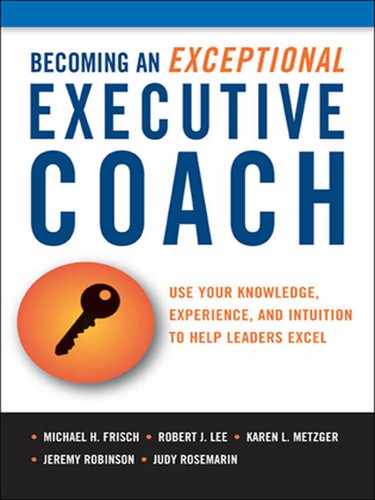Notes
Chapter 3: Foundations and Definitions
1. Mary Beth O’Neill, Executive Coaching with Backbone and Heart: A Systems Approach to Engaging Leaders with Their Challenges, 2nd ed. (San Francisco: Jossey-Bass, 2007), 5.
2. David L. Dotlich and Peter C. Cairo, Action Coaching: How to Leverage Individual Performance for Company Success (San Francisco: Jossey-Bass, 1999), 18.
3. James Flaherty, Coaching: Evoking Excellence in Others, 2nd ed. (Burlington, MA: Butterworth-Heinemann, 2005), xviii and 9.
4. Robert Hargrove, Masterful Coaching, 3rd ed (San Francisco: Jossey-Bass, 2008), 17.
5. Eric de Haan and Yvonne Burger, Coaching with Colleagues: An Action Guide to One-to-One Learning (Hampshire, UK: Palgrave Macmillan, 2005), 5.
6. Richard R. Kilburg. “When Shadows Fall: Using Psychodynamic Approaches in Executive Coaching,” Consulting Psychology Journal: Practice and Research 56, no. 4 (2004), 246–68; Manfred Kets De Vries, Konstantin Korotov, and Elizabeth FlorentTreacy, Coach and Couch: The Psychology of Making Better Leaders (New York: Palgrave Macmillan, 2007); and Harry Levinson,’ “Executive Coaching,” Consulting Psychology Journal: Practice and Research 48, no. 2 (1996), 115–23.
7. Daniel J. Levinson, Charlotte N. Darrow, Edward Klein, Maria H. Levinson, and Braxton McKee, The Seasons of a Man’s Life (New York: Ballantine Books; 1978), and Steven D. Axelrod, “Executive Growth Along the Adult Development Curve,” Consulting Psychology Journal: Practice and Research 57, no. 2 (2005), 118–25.
8. Marshall Goldsmith and Laurence Lyons. Coaching for Leadership, 2nd ed. (San Francisco: Pfeiffer, 2006).
9. Daniel Goleman, Richard Boyatzis, and Annie McKee, Primal Leadership: Realizing the Importance of Emotional Intelligence (Boston: Harvard University Press, 2002), and Martin E. P. Seligman. Authentic Happiness: Using the New Positive Psychology to Realize Your Potential for Lasting Fulfillment (New York: Free Press, 2002).
10. Flaherty, Coaching: Evoking Excellence in Others.
11. Daniel White, Coaching Leaders: Guiding People Who Guide Others (San Francisco: Jossey-Bass, 2005); and David B. Peterson and J. Miller, “The Alchemy of Coaching: ‘You’re Good, Jennifer, but You Could Be Really Good,’” Consulting Psychology Journal: Practice and Research 57, no. 1 (2005), 14–40.
12. For learning models, Eric de Haan, Relational Coaching: Journeys Towards Mastering One-to-One Learning (West Sussex, UK: John Wiley & Sons, 2008); for system approaches, O’Neill, Executive Coaching with Backbone and Heart.
Chapter 7: Building Early Relationships with Clients
1. D. D. McKenna and S. L. Davis, “Hidden in Plain Sight: The Active Ingredients of Executive Coaching,” Industrial and Organizational Psychology; Perspectives on Science and Practice 2, no. 3 (2009), p. 244–60.
2. C. C. DiClemente and J. O. Prochaska, “Toward a Comprehensive, Transtheoretical Model of Change,” in Treating Addictive Behaviors, 2nd edition, ed. W. R. Miller and N. Heather (New York: Plenum Press, 1998), pp. 3–24.
3. William R. Miller and Stephen Rollnick, Motivational Interviewing: Preparing People for Change, 2nd ed. (New York: Guildford Press, 2002).
Chapter 12: Encouraging Dialogue and Stories
1. Dan P. McAdams, The Stories We Live By (New York: Guilford, 1993).
Chapter 13: Strengthening the Partnership
1. McKenna and Davis, “Hidden in Plain Sight,” 244–60.
Chapter 15: Coaching for Leadership
1. Sarah N. King, David G. Altman, and Robert J. Lee, Discovering the Leader in You, 2nd ed. (San Francisco: Wiley, 2011).
2. Lori Silverman, Wake Me When the Data Is Over: How Organizations Use Storytelling to Drive Results (San Francisco: Jossey- Bass, 2006).
3. Robert E. Kaplan and Robert B. Kaiser, The Versatile Leader (San Francisco: Pfeiffer, 2006).
Chapter 17: Closure
1. Martin E. P. Seligman, Authentic Happiness (New York: Free Press, 2002).
Chapter 18: What Happened: Self-Reflection and Evaluation
1. Donald L. Kirkpatrick, “Evaluating Training Programs: Evidence vs. Proof,” Training and Development Journal 31 (1977), 9–12.
2. Kenneth P. De Meuse, Guangrong Dai, and Robert J. Lee, “Evaluating the Effectiveness of Executive Coaching: Beyond ROI?” Coaching: An International Journal of Theory, Research, and Practice 2, no. 2 (2009), 118–35.
Chapter 19: Professionalism and Responsibility
1. Michael H. Frisch. “Coaching Caveats Part 1: Characteristics of the Organization,” Human Resource Planning 28, no. 2 (2005), 13–15; and Michael H. Frisch, “Coaching Caveats Part 2: Characteristics of the Coachee,” Human Resource Planning 28, no. 3 (2005), 14–16.
Chapter 20: The Role of the Internal Coach
1. Michael H. Frisch, “The Emerging Role of the Internal Coach,” Consulting Psychology Journal: Practice and Research 53, no. 4 (Autumn 2001), 240–50.
Chapter 24: Becoming an Exceptional Executive Coach: Amber’s Story
1. Amber’s story is a fictional composite of student experiences in becoming executive coaches; quotes are invented. Like all stories, some of Amber’s story reflects her individuality, since coaching encompasses a diverse population. Largely, however, her experience of becoming an executive coach is typical and intended to illustrate key milestones along that journey.
